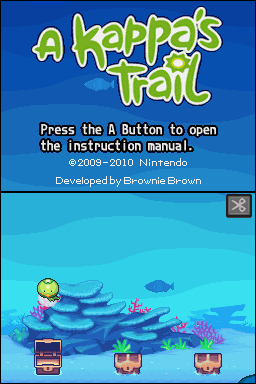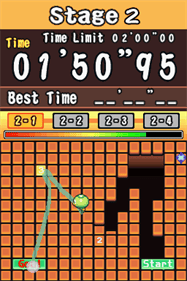- Retro XP
- Posts
- Re-release this: A Kappa's Trail
Re-release this: A Kappa's Trail
A Brownie Brown rarity, in that it's not an RPG, but also in the sense that it released as DSiWare and is no longer available anywhere.
This column is “Re-release this,” which will focus on games that aren’t easily available, or even available at all, but should be once again. Previous entries in this series can be found through this link.
Nintendo subsidiary Brownie Brown has been around for 25 years now, though, not always under that name. While they’re currently known as 1-Up Studio, and more for their work as a support studio co-developing significant Nintendo projects alongside the likes of Nintendo EAD or Nintendo EPD, for the first half of their existence, their focus was mostly, but not exclusively, on role-playing games. These games were published (and sometimes co-developed) by a number of studios, including Nintendo — which funded Brownie Brown, so of course — as well as Square Enix — Brownie Brown’s founders and some employees were former Square artists — and the likes of Marvelous (Livly Garden), AQ Interactive (Blue Dragon Plus), and Level-5 (Professor Layton’s London Life; Fantasy Life).
The most significant of Brownie Brown’s pre-1-Up Studio work, however, is easily Mother 3, which they co-developed alongside HAL Laboratory and series creator (and writer) Shigesato Itoi. Their ability to collaborate was a clear strength, considering the titles that came out of those processes, and a not insignificant reason for why they ended up as a support studio working on the likes of Captain Toad: Treasure Tracker, Super Mario 3D World, Super Mario Odyssey, and Animal Crossing: New Horizons. It’s a bummer, in a way, that they can’t work on original titles any longer in this role, but given they worked almost exclusively in Nintendo’s handheld space, and Nintendo doesn’t have one of those anymore, it’s not quite analogous to Activision banishing successful studios to the office basement to work on making Call of Duty or Diablo assets in perpetuity. Hopefully not, anyway — the extremely closed-off nature of Nintendo’s development makes it difficult to know for sure who is doing what, exactly, but generally speaking it feels safe to regard anyone as “not quite analogous to Activision”. Pick your targets with care, kids, it’s the responsible thing to do.
Before the support studio role, before even Brownie Brown, those who started the company were mostly disgruntled Square employees who wanted to work somewhere else. A tale not quite as old as time, but at least a pretty damn common one for the mid-to-late-90s. Monolith Soft (Xenosaga, Baten Kaitos, Xenoblade) was founded by Hirohide Sugiura, Tetsuya Takahashi, and Yasuyuki Honne, all ex-Square, and, in the case of Takahashi and Honne, ex-Xenogears development team, as well. Those two items are related: the development of Xenogears happened mostly because Takahashi — and Kaori Tanaka, aka Soraya Saga — had enough allies at Square to force the issue, but post-Xenogears, Square wanted more Final Fantasy, the thing Takahashi and his team had already walked away from once before. Suguira was a producer at Square who did like Xenogears, and believed it was time for a split, so, Monolith Soft was born. This is the short version of a much longer story that Kotaku covered in-depth back in 2020 — it’s worth your time.

Image credit: MobyGames
Before Monolith split off from Square, taking multiple employees with it, there was Love-de-Lic. This studio formed in 1995, founded by ex-Square developer Kenichi Nishi, and would go on to develop some serious (cult) classics like Moon: RPG Remix Adventure and Lack of Love — an impressive feat considering they made just three games before closing shop in 2000, and then split off into three other studios: Punchline, which developed Rule of Rose and Chulip, Vanpool, which has had their hand in a number of Kirby titles as well as Zelda spin-off Freshly-Picked Tingle’s Rosy Rupeeland, and Skip Ltd., responsible for the likes of Chibi-Robo! and most of the Art Style series of games, including some real winners like PiCTOBiTS.
You might be sensing a theme here. Well, two. None of those games are very Square-like, even at Square’s most adventurous. (Hey, I’m not picking on them, they’ve just got a type.) And second, Nintendo had a real thing for these former Square devs making their own studios. Skip Ltd. was a second-party developer, Monolith was eventually fully acquired by the Big N — with Monolith making Baten Kaitos for the GameCube before that acquisition at the insistence of Satoru Iwata — and then there’s Brownie Brown, which had stuck to Nintendo platforms and was both funded by and often published by them before they were fully acquired and renamed in a restructuring.
The founders of Brownie Brown were Shinichi Kameoka and Kouji Tsuda, two ex-Square developers who had worked on the Mana series while with the RPG behemoth. Kameoka wanted to make the games that he wanted to make, not the ones Square wanted him to make, which just happened to be Final Fantasy games. Hey, another theme. This isn’t a guess, either, but straight from Kameoka himself:
One of the reasons I originally left Squaresoft back then in the first place is because they wanted me to make Final Fantasy games and I wasn’t really interested in the 3D art style and the direction that Final Fantasy was going in back in 2000. So he [sic] went to Brownie Browns to make my own games and so they were focused on Nintendo games for Nintendo consoles. At one point, Nintendo asked Brownie Browns to help out with a Mario game. And I was like “That’s not really what I want to do. I want to do my own thing!”
This was also after Kameoka left Brownie Brown during the transition to 1-Up Studio, with, instead of Final Fantasy, the catalyst being Nintendo wanting them to work on a Mario game. (It’s not named in the interview, but the timeline suggests that it was Super Mario 3D World.) The “younger” developers were interested in that kind of development, while Kameoka was not, so he left to form another studio, Brownies, which has worked on titles like Doraemon: Story of Seasons and Egglia.
This is a lot of backstory, but it feels necessary at a time when Brownie Brown is now a support studio under a Mario-related name and Skip Ltd. is no more. The kinds of games Nintendo is interested in putting their name on or putting resources into or marketing has changed over the years, and recognizing that sort of thing matters in a moment where I’m about to say that this particular Brownie Brown game should be re-released in the present. A Kappa’s Trail was a DSiWare exclusive that you could buy for $4.99, and, since the 3DS eShop closed down, it is no longer available through any legal means. It’s one of the best games Brownie Brown ever developed, but, is also the kind of game that existed for a very specific system that none of Nintendo’s current hardware can replicate 1:1, and was only given so much marketing as a $5 digital-only game released in an era where Nintendo was still figuring out how they were going to handle any of that. Nintendo Directs didn’t even kick off for another year after the North American release of A Kappa’s Trail, and it’s not like DSiWare was ever a high priority outside of the launch of the service. Killer games released on the system regularly, but you had to be looking and buying to know that.
While Brownie Brown’s work making their own games for Nintendo systems tended to leave them in the RPG space that their Square pedigree prepared them for — Brownie Brown is responsible for Magical Vacation, Magical Starsign, the Mana-series games Square Enix made for Nintendo systems after the two made up following their 90s falling out, and, of course, the crown jewel of their solo time, Mother 3 — A Kappa’s Trail is a platformer. And despite its status as a little known, digital-only release on the underrated DSiWare storefront, it likely contributed in part to their shift to assisting on major platformers for Nintendo. It’s a devious game that used the DSi’s input system — the stylus — to great, multipurpose effect, and it’s not hard to believe that these same developers would have ideas about utilizing the Wii U’s specific hardware features for a brand new Mario title.
A Kappa’s Trail is a deceptively difficult and involved platformer, where you use the stylus to draw a path for a Kappa to reach the exit of the stage. A simple enough premise, but the path is full of enemies that you cannot directly attack, you have limited health, the floor is constantly falling away or the lights are turning off or boulders are falling from the ceiling or the floor is vanishing in some kind of fall-to-your-death memory game, and also, a giant demon hand falls from the sky and perfectly follows the path you drew for your Kappa, and if it reaches him, you fail and have to start the stage over.
So! You are attempting to draw a path to safety and continue to update that path to navigate around enemies, around obstacles, and to make sure you don’t accidentally double back into the hand chasing you, which will instantly make for a game over, or bump into enemies who are also patrolling around, which will merely sap some of your limited health. You need to collect coins so you can purchase health items, upgrades, and so on, but attempting to collect coins also makes the stages significantly more difficult, since it involves traversing every square inch of them instead of trying to stay to a tighter, and often safer, path. However, without the upgrades coins can buy you, such as the Fate Orbs that act as an extra life that allows you to continue from where your Kappa failed, the stages become significantly more difficult! This game is as tough as it is cute, and let me tell you: it is cute.

Image credit: LaunchBox Games Database
A Kappa is a Japanese kami, which is to say a being of nature associated with the Shinto religion. A Kappa bears similarities to a turtle in some respects, such as with the carapace on their backs. The most notable aspect of a Kappa, however, especially for the purposes of A Kappa’s Trail, is the dish on top of their head. It’s full of water, and if that water were to spill or be lost somehow, the Kappa itself becomes weakened. Crash into an enemy in A Kappa’s Trail? You lose some of that water, and therefore health. Fall down a hole? You know you spilled some water. Grabbed by the head by the floating devil hand that endlessly and mercilessly chases you? Oh yeah that water is gone. Your goal is to get from one pond at the start of a level to the one at the end of the level without having lost all of the water in that dish.
There are ways to restore the Kappa’s health, at least, and that’s through cucumbers. That a cucumber is a preferred food of the Kappa is wonderful for a couple of reasons, the first being that a cucumber is also green and, like depictions of a Kappa, doesn’t necessarily exist in one universal form. The second is that cucumbers are basically water that you can chew, so of course a Kappa would adore its hydrating capabilities. You either find an actual cucumber item sometimes — a rarity, but they do exist in the stages sometimes — or you find a tiny little Kappa hiding in a boulder or a tiny depression in the ground that you walk over and poof, a Kappa pops out of a dust cloud. That Kappa either has a cucumber in its mouth already, or will go digging for one in a hurry. Approach it, and restore some health.
These little Kappa pals help in other ways, as well. The gray ones latch onto your back and jump off to beat up whatever enemy they come into the range of first — hopefully before said enemy causes you any harm. There are yellow ones that help light up rooms where darkness is a constant issue that you’d normally have to scroll with the stylus to find a lamp that you’d then tap a bunch, all while hoping nothing damages you or snatches you with its floating devil fingers while you’re away. The purple ones become bridges for you to help you cross platforms, and are the most necessary of all of the Kappa friends. At a level’s end, a bunch of these purple buds can link up into one longer bridge for you to cross, which means finding them all is imperative. There is also a special Kappa that you can unlock by popping a whole bunch of balloons that are floating by you on occasion — it takes 40 stylus taps to do this — and it will then defeat the devil hand. It doesn’t permanently defeat it in a stage, no, but you get one hell of a respite from it, which is more than you can say at literally any other point in any stage in A Kappa’s Trail. That thing is constantly on your tail, since it follows your own movements exactly, and doesn’t give you as much of a head start as you’d like, either.

Image credit: LaunchBox Games Database
There are four sets of four levels a piece, and they’re basically teaching you the various concepts you need to learn, and named for those concepts, as well, all building on top of each other as you go. The second stage is called “Darkness,” while the third is “Movement,” and the fourth is “Pursuit.” Basically they’re all named after new stuff being introduced that can kill you, so that you can learn how to not be killed by it. The number of things that can hurt or kill you stack up, and fast, and make A Kappa’s Trail real difficult to complete with ease. But that’s why you want to pick up every coin that you see, so that you can buy Fate Orbs from the shop in the starting area, and use them as extra lives to brute force your way through the levels. You can always return to old levels later and give defeating them with one life a shot, but there’s no shame in failure to do that, either. It’s not like the game is easy even if you’ve got Fate Orbs to spare.
I cannot recommend A Kappa’s Trail enough, and that’s without even getting into the additional three games tucked away within it. There’s Trial of Tiles, which is a falling-tile minigame where you try to make it from the starting line to the goal line without falling — a difficult task given that these tiles are falling, limiting how much you can double back or take new routes. There’s Plate Master, which is a memory game. And there’s Devil Hand Dungeon, which should be pretty self-explanatory: it is a devil hand-focused minigame where hey, you still do not want to be caught by it. A Kappa’s Trail tells you that these minigames can actually improve your play of the main game, and given what they ask of you, and that it all relates back to how to play said main game — accuracy and thoughtfulness in pathfinding, memorization of the map, and avoiding that devilish hand — there’s no room to disagree.
Now here’s the real issue, outside of that A Kappa’s Trail is not available. There’s no current hardware that would make the game play as intended that Nintendo also puts games on. At least not until the Switch 2 arrives, anyway. The Switch 2 mouse mode could replicate the stylus-based gameplay, either using one Mouse-con for everything like the stylus was utilized on the DSi, or one Mouse-Con for your navigation — i.e. moving the playing area around — and the other for drawing Kappa’s paths. The map from the top screen could be built in on the side of the screen instead, so you could still easily see where everything is in relation to Kappa, which is extremely necessary in many stages, especially ones with time-sensitive features like lights you must manipulate back on. It’s doable in a way it wasn’t on the Switch — at least not comfortably, since drawing lines with an analog stick is a lot different in terms of precision and speed than a stylus.
Of course, Nintendo has to want to re-release A Kappa’s Trail. And since they moved on from funding and publishing these kinds of experiences in the first place — the era of the Switch had loads of hits and creativity, yes, but it was also a deviation from the kind of experimentation that the company focused on with the DSiWare, the 3DS, and Wii U digital shops — it’s unclear if they would want to. It’s possible, though, that a number of DS and DSi and 3DS titles will get a second life on the Switch 2, given the mouse mode exists, so there’s nothing definitive to say on that note just yet. Outside of that A Kappa’s Trail is definitely a game you should want to experience, regardless.
Portions of this write-up originally appeared in Retro XP in a compilation feature on games that just missed the Nintendo top 101.
This newsletter is free for anyone to read, but if you’d like to support my ability to continue writing, you can become a Patreon supporter, or donate to my Ko-fi to fund future game coverage at Retro XP.